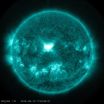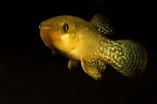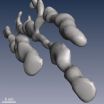(Press-News.org) The sun emitted a significant solar flare, peaking at 1:48 p.m. EDT on Sept. 10, 2014. NASA's Solar Dynamics Observatory captured images of the event.
Solar flares are powerful bursts of radiation. Harmful radiation from a flare cannot pass through Earth's atmosphere to physically affect humans on the ground. However -- when intense enough -- they can disturb the atmosphere in the layer where GPS and communications signals travel.
To see how this event may affect Earth, please visit NOAA's Space Weather Prediction Center at http://spaceweather.gov, the U.S. government's official source for space weather forecasts, alerts, watches and warnings.
This flare is classified as an X1.6 class flare. "X-class" denotes the most intense flares, while the number provides more information about its strength. An X2 is twice as intense as an X1, an X3 is three times as intense, etc.
Updates will be provided as needed.
INFORMATION:
What is a solar flare?
For answers to this and other space weather questions, please visit the Spaceweather Frequently Asked Questions page: http://www.nasa.gov/mission_pages/sunearth/spaceweather/index.html
NASA sees a significant flare surge off the sun
2014-09-10
ELSE PRESS RELEASES FROM THIS DATE:
Study provides more evidence that sleep apnea is hurting your brain
2014-09-10
Employing a measure rarely used in sleep apnea studies, researchers at the UCLA School of Nursing have uncovered evidence of what may be damaging the brain in people with the sleep disorder — weaker brain blood flow.
In the study, published Aug. 28 in the peer-reviewed journal PLOS ONE, researchers measured blood flow in the brain using a non-invasive MRI procedure: the global blood volume and oxygen dependent (BOLD) signal. This method is usually used to observe brain activity. Because previous research showed that poor regulation of blood in the brain might be a problem ...
Sharks more abundant on healthy coral reefs
2014-09-10
Sharks in no-fishing zones in the Great Barrier Reef (GBR) Marine Park are more abundant when the coral is healthy, according to a study published September 10, 2014 in the open-access journal PLOS ONE by Mario Espinoza from James Cook University, Australia and colleagues.
Shark species that use coral reefs may be under pressure from fishing, habitat degradation, and climate change. The authors of this study were interested in understanding the factors that affect the distribution and abundance of shark populations in the GBR, including fishing and habitat quality. To ...
Gulf killifishes' biological responses to oil spills similar in field, laboratory studies
2014-09-10
Gulf killifish biological responses to the Deepwater Horizon oil spill detected by researchers in the field are similar to those in controlled laboratory studies, according to a study published September 10, 2014 in the open-access journal PLOS ONE by Whitney Pilcher from Louisiana State University and colleagues.
After the Deepwater Horizon oil spill, scientists monitored the impacts of oil on a local species of fish, the Gulf killifish. Changes in genome expression responses to oil exposure may provide insight into how the fish are affected by or adapt to environmental ...
New study shows impact of movies on dog breed popularity
2014-09-10
The effect of movies featuring dogs on the popularity of dog breeds can last up to ten years and is correlated with the general success of the movies, according to new research from the University of Bristol, the City University of New York, and Western Carolina University.
The study, published today in PLOS ONE, also found that movies' influence was strongest in the early twentieth century and has declined since.
The researchers used data from the American Kennel Club, which maintains the world's largest dog registry totalling over 65 million dogs, and analysed a total ...
New 3-D imaging techniques may improve understanding of biofuel plant material
2014-09-10
Comparison of 3D TEM imaging techniques reveals never-seen-before details of plant cell walls, according to a study published September 10, 2014 in the open-access journal PLOS ONE by Purbasha Sarkar from University of California, Berkeley and colleagues.
Cost-effective production of plant material for biofuel requires efficient breakdown of plant cell wall tissue to retrieve the complex sugars in the cell wall required for fermentation and production of biofuels. In-depth knowledge of plant cell wall composition is therefore essential for improving the fuel production ...
New study examines impact of violent media on the brain
2014-09-10
(NEW YORK – September 10, 2014) With the longstanding debate over whether violent movies cause real world violence as a backstop, a study published today in PLOS One found that each person's reaction to violent images depends on that individual's brain circuitry, and on how aggressive they were to begin with.
The study, which was led by researchers at the Icahn School of Medicine at Mount Sinai and the NIH Intramural Program, featured brain scans which revealed that both watching and not watching violent images caused different brain activity in people with different ...
Study ties groundwater to human evolution
2014-09-10
Our ancient ancestors' ability to move around and find new sources of groundwater during extremely dry periods in Africa millions of years ago may have been key to their survival and the evolution of the human species, a new study shows.
The research – published in the journal PLOS ONE – combines geological evidence from the Olduvai sedimentary basin in Northern Tanzania, which formed about 2.2 million years ago, and results from a hydrological model.
It shows that while water in rivers and lakes would have disappeared as the climate changed due to variations in the ...
Is spooning really the best position for men with back pain?
2014-09-10
September 10, 2014 – A study using motion capture technology provides new information on the spinal strain produced by various sexual positions—suggesting that one position commonly recommended for all men with low back pain is not actually the best choice, reports a study in the journal Spine. The journal is published by Lippincott Williams & Wilkins, a part of Wolters Kluwer Health.
The results provide a more scientific basis for making individualized recommendations regarding sexual positions for men with low back pain, according to Natalie Sidorkewicz, MSc, and Stuart ...
Seismic gap may be filled by an earthquake near Istanbul
2014-09-10
When a segment of a major fault line goes quiet, it can mean one of two things: The "seismic gap" may simply be inactive — the result of two tectonic plates placidly gliding past each other — or the segment may be a source of potential earthquakes, quietly building tension over decades until an inevitable seismic release.
Researchers from MIT and Turkey have found evidence for both types of behavior on different segments of the North Anatolian Fault — one of the most energetic earthquake zones in the world. The fault, similar in scale to California's San Andreas Fault, ...
Gibbon genome sequence deepens understanding of primates rapid chromosomal rearrangements
2014-09-10
HOUSTON – (Sep. 10. 2014) – With the completion of the sequencing and analysis of the gibbon genome, scientists now know more about why this small ape has a rapid rate of chromosomal rearrangements, providing information that broadens understanding of chromosomal biology.
Chromosomes, essentially the packaging that encases the genetic information stored in the DNA sequence, are fundamental to cellular function and the transmission of genetic information from one generation to the next. Chromosome structure and function is also intimately related to human genetic diseases, ...


